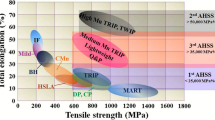Abstract
The present paper summarizes recent and on-going work on the exploitation of TRansformation-Induced Plasticity (TRIP) in an effort to develop automotive steels which would possess high-strength combined with high formability while these steels could also exhibit high fracture and fatigue resistance. Especially for the automotive industry, the driving force for these developments is the vehicle weight reduction, which could eventually lead to lower fuel consumption combined with reduced greenhouse gas emissions.
The discussion starts with the modelling and characterization of the retained austenite stability (the transforming phase) as well as the modelling of the transformation kinetics, i.e. evolution of transformation with plastic strain.
Enhancement of formability is discussed next. Constitutive micromechanical modelling has been employed for the calculation of forming limit diagrams (FLD) for these complex steels, an issue of great practical importance for the optimisation of stretch-forming and deep-drawing operations.
Fracture resistance can be considerably increased by the TRIP effect. A review is made of the “transformation toughening” arising from metastable austenitic dispersions in ultrahigh strength steels and the high fracture toughness achieved in this class of materials. The potential of the TRIP effect in increasing fatigue strength has not yet received considerable attention. However once we understand the fatigue behaviour of these materials, new applications, e.g. long products made of TRIP steel, might emerge for automotive applications.
Access this chapter
Tax calculation will be finalised at checkout
Purchases are for personal use only
Preview
Unable to display preview. Download preview PDF.
Similar content being viewed by others
References
Olson, G.B., Mechanically-Induced Phase Transformations in Alloys, Encyclopedia of Materials Science and Engineering (ed.) Bever, M.B., Pergamon Press, Cambridge, MA, 2929–2932 (1986).
Haidemenopoulos G.N., Grujicic M., Olson G.B., and Cohen M., “Transformation Microyielding of Retained Austenite”, Acta Metall., Vol. 37, No. 6, pp. 1677–1682 (1989).
Vasilakos A.N., Papamantellos K., Haidemenopoulos G.N., and Bleck W., “Experimental Determination of the Stability of Retained Austenite in Low-Alloy TRIP Steels”, Steel Res., Vol. 70, No. 11, pp. 466–471 (1999).
Haidemenopoulos G.N and Vasilakos A.N., “Modelling of Stability in Low Alloy Triple-Phase Steels”, Steel Res., Vol. 67, No. 11, pp. 513–519 (1996).
Azuma, M., Fujita, N., Takahashi, M., Senuma, T., Quidort, D., and Lung, T., “Modelling Upper and Lower Bainite Transformation in Steels”, ISIJ Int., Vol. 45, No. 2, pp. 221–228 (2005).
Katsamas, A. and Haidemenopoulos, G.N., Research Work in Progress, University of Thessaly, Volos, Greece (2008).
Haidemenopoulos, G.N., Katsamas, A., and Aravas, N., “Stability and Constitutive Modelling in Multiphase TRIP Steels”, Steel Res. Int., Vol. 77, No. 9–10, pp. 720–726 (2006).
Papatriantafillou, I., Agoras, M., Aravas, N., and Haidemenopoulos G., “Constitutive Modeling and Finite Element Methods for TRIP Steels”, Comput. Meth. Appl. Mech. Eng., Vol. 195, pp. 5094–5114 (2006).
Stringfellow R.G., Parks D.M., and Olson G.B., “A Constitutive Model for Transformation Plasticity Accompanying Strain-Induced Martensitic Transformation in Metastable Austenitic Steels”, Acta Metall. Mater., Vol. 40, pp. 1703–1716 (1992).
Haidemenopoulos, G.N., Dispersed-Phase Transformation Toughening in Ultrahigh-Strength Steels, Doctoral thesis, Department of Materials Science and Engineering, Massachusetts Institute of Technology, Cambridge, MA (1988).
Haidemenopoulos, G.N., Olson, G.B., and Cohen, M., Dispersed-Phase Transformation Toughening in Ultrahigh-Strength Steels, Proceedings of 34th Sagamore Army Materials Conference on Innovations in Ultrahigh-Strength Steel Technology (eds.) Olson, G.B., Azrin, M., and Wright, E.S., pp. 549–592 (1990).
Papaefthimiou, S., Failure Mechanisms of Multiphase Steels, Doctoral thesis, IEHK, RWTH Aachen, Germany (2005).
Sugimoto, S.I., Kobayashi, K.I., and Hashimoto, S.I., “Low-Cycle Fatigue Hardening of TRIP-Aided Dual Phase Steels”, J. Jpn. Inst. Met., Vol. 54, No. 12, pp. 1350–1357 (1990).
Yokoi, T., Kawasaki, K., Takahashi, M., and Mitzui, M., “Fatigue Properties of High Strength Steels Containing Retained Austenite”, JSAE Rev., Vol. 17, No. 1, pp. 210–212 (1996).
Hu, Z.Z., Ma, M.L., Liu, Y.Q., and Liu, J.H., “The Effect of Austenite on Low Cycle Fatigue in Three-Phase Steel”, Int. J. Fatigue, Vol. 19, No. 8–9, pp. 641–646 (1997).
Dimakarakou, E., Austenite Stabilization, Cyclic Deformation and Fatigue of Low-Alloy TRIP Steels, Doctoral thesis Research in Progress, Department of Mechanical Engineering, University of Thessaly, Volos, Greece (2008).
Author information
Authors and Affiliations
Corresponding author
Editor information
Editors and Affiliations
Rights and permissions
Copyright information
© 2009 Springer Science+Business Media B.V
About this paper
Cite this paper
Haidemenopoulos, G.N. (2009). Exploitation of the TRIP Effect for the Development of Formable, Fracture and Fatigue Resistant Steels for Automotive Applications. In: Pantelakis, S., Rodopoulos, C. (eds) Engineering Against Fracture. Springer, Dordrecht. https://doi.org/10.1007/978-1-4020-9402-6_3
Download citation
DOI: https://doi.org/10.1007/978-1-4020-9402-6_3
Publisher Name: Springer, Dordrecht
Print ISBN: 978-1-4020-9401-9
Online ISBN: 978-1-4020-9402-6
eBook Packages: Chemistry and Materials ScienceChemistry and Material Science (R0)




